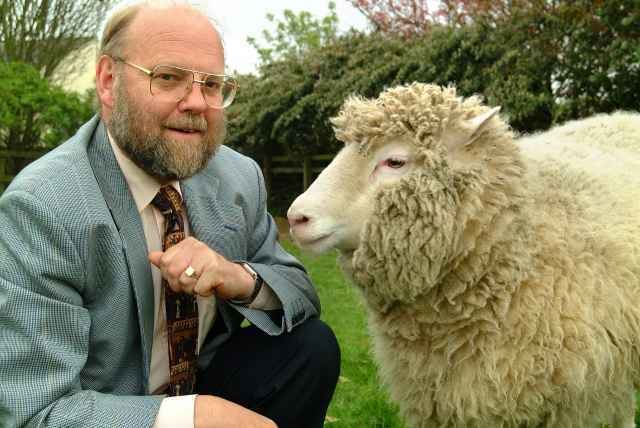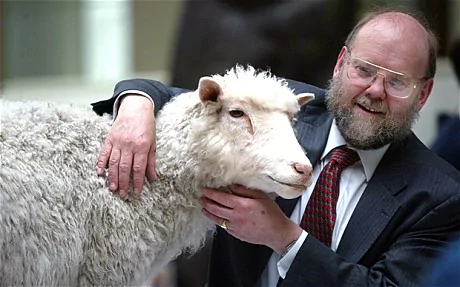Residence Edinburgh, Scotland Role Researcher Nationality English | Fields Embryologist Name Ian Wilmut | |
 | ||
Institutions The Roslin InstituteUniversity of Edinburgh Alma mater University of NottinghamUniversity of Cambridge Thesis The preservation of boar semen (1971) Books The Second Creation, Dolly. Der Aufbruch ins biotechnische Zeitalter Similar People Keith Campbell, Colin Tudge, Christopher Polge | ||
Doctoral advisor Christopher Polge | ||
From dolly to curing human disease sir ian wilmut at tedxsalford
Sir Ian Wilmut, OBE FRS FMedSci FRSE (born 7 July 1944) is a British embryologist and Chair of the Scottish Centre for Regenerative Medicine at the University of Edinburgh. He is best known as the leader of the research group that in 1996 first cloned a mammal from an adult somatic cell, a Finnish Dorset lamb named Dolly. He was appointed OBE in 1999 for services to embryo development and knighted in the 2008 New Year Honours.
Contents
- From dolly to curing human disease sir ian wilmut at tedxsalford
- Prof Sir Ian Wilmut The Quest for New Therapies by Stem Cell Research
- Early life and education
- Career and research
- Awards and honours
- References

Prof. Sir Ian Wilmut - The Quest for New Therapies by Stem Cell Research
Early life and education
Wilmut was born in Hampton Lucy, Warwickshire, England. Wilmut's father, Leonard Wilmut, was a mathematics teacher who suffered from diabetes for fifty years eventually causing blindness. He was a student of the former Boys' High School, in Scarborough, where his father taught. Wilmut's early desire was to embark on a naval career, but he was unable to do so due to his colour blindness. As a school boy, Wilmut worked as a farm hand on weekends, which inspired him to study Agriculture at the University of Nottingham.
In 1966 Wilmut spent 8 weeks working in the laboratory of Christopher Polge, who is credited with developing the technique of cryopreservation in 1949. The following year, Wilmut joined Polge's laboratory to undertake a Doctor of Philosophy degree at the University of Cambridge from which he graduated in 1971 with a thesis on the semen cryopreservation. During this time he was a postgraduate student at Darwin College, Cambridge.
Career and research
Since his PhD, he has been involved in research focusing on gametes and embryogenesis, including working at the Roslin Institute.
Wilmut was the leader of the research group that in 1996 first cloned a mammal, a lamb named Dolly. Dolly died of a respiratory disease in 2003. However, in 2008 Wilmut announced that he would abandon the technique of somatic cell nuclear transfer by which Dolly was created in favour of an alternative technique developed by Shinya Yamanaka. This method has been used in mice to derive pluripotent stem cells from differentiated adult skin cells, thus circumventing the need to generate embryonic stem cells. Wilmut believes that this method holds greater potential for the treatment of degenerative conditions such as Parkinson's disease and to treat stroke and heart attack patients.
Wilmut led the team that created Dolly, but in 2006 admitted his colleague Keith Campbell deserved "66 per cent" of the invention that made Dolly's birth possible, and that the statement "I did not create Dolly" was accurate. His supervisory role is consistent with the post of principal investigator held by Wilmut at the time of Dolly's creation.
Wilmut is an Emeritus Professor at the Scottish Centre for Regenerative Medicine at the University of Edinburgh and in 2008 was knighted in the New Year Honours for services to science.
In 2006 his book After Dolly: The Uses and Misuses of Human Cloning was published, co-authored with Roger Highfield.
Awards and honours
In 1998 he received the Lord Lloyd of Kilgerran Award. Wilmut was appointed Order of the British Empire (OBE) in 1999 and a Fellow of the Royal Society (FRS) in 2002. He is also an elected Fellow of the Academy of Medical Sciences in 1999 and Fellow of the Royal Society of Edinburgh. He was elected an EMBO Member in 2003.
In 1997 Wilmut was Time magazine man of the year runner up. He was knighted in the 2008 New Year Honours.
